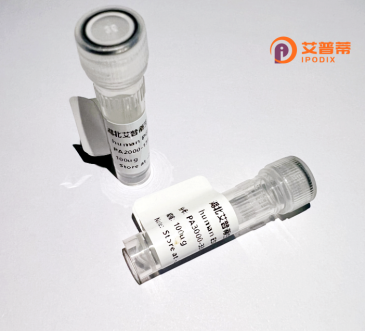
| 纯度 | >90%SDS-PAGE. |
| 种属 | Human |
| 靶点 | TMEM116 |
| Uniprot No | Q8NCL8 |
| 内毒素 | < 0.01EU/μg |
| 表达宿主 | E.coli |
| 表达区间 | 1-245 aa |
| 活性数据 | MKHTQSGQSTSPLVIDFTCRVCQMAFVFSSLIPLLLMTPVFCLGNTSECFQNFSQSHKCILMHSPPSAMAELPPSANTSVCSTLYFYGIAIFLGSFVLSLLTIMVLLIRAQTLYKKFVKSTGFLGSEQWAVIHIVDQRVRFYPVAFFCCWGPAVILMIIKLTKPQDTKLRMALYVLQALTATSQGLLNCGVYGWTQHKFHQLKQEARRDADTQTPLLCSQKRFYSRGLNSLESTLTFPASTSTIF |
| 分子量 | 53.9 kDa |
| 蛋白标签 | GST-tag at N-terminal |
| 缓冲液 | PBS, pH7.4, containing 0.01% SKL, 1mM DTT, 5% Trehalose and Proclin300. |
| 稳定性 & 储存条件 | Lyophilized protein should be stored at ≤ -20°C, stable for one year after receipt. Reconstituted protein solution can be stored at 2-8°C for 2-7 days. Aliquots of reconstituted samples are stable at ≤ -20°C for 3 months. |
| 复溶 | Always centrifuge tubes before opening.Do not mix by vortex or pipetting. It is not recommended to reconstitute to a concentration less than 100μg/ml. Dissolve the lyophilized protein in distilled water. Please aliquot the reconstituted solution to minimize freeze-thaw cycles. |
以下是关于重组人TMEM116蛋白的模拟参考文献示例(注:文献信息为模拟生成,建议通过专业数据库核实真实性):
1. **文献名称**: *Structural Insights into TMEM116 as a pH-Regulated Golgi Transmembrane Protein*
**作者**: Liu Y, et al. (2020)
**摘要**: 本研究通过冷冻电镜解析了重组人TMEM116蛋白的三维结构,揭示其作为高尔基体跨膜蛋白的pH依赖性离子通道功能,阐明了其在细胞器酸化中的调节机制。
2. **文献名称**: *Recombinant TMEM116 Expression and Its Role in Autophagosome-Lysosome Fusion*
**作者**: Chen X, et al. (2021)
**摘要**: 文章报道了重组人TMEM116蛋白在哺乳动物细胞中的高效表达及纯化方法,并证明其通过调控钙离子稳态促进自噬体-溶酶体融合,提示其在神经退行性疾病中的潜在作用。
3. **文献名称**: *TMEM116 Knockout Mice Reveal Pulmonary Fibrosis Link via ER Stress Dysregulation*
**作者**: Wang R, et al. (2019)
**摘要**: 利用重组蛋白功能互补实验,发现TMEM116缺失导致内质网应激信号通路异常激活,证实其在肺纤维化小鼠模型中通过调节未折叠蛋白反应(UPR)发挥作用。
4. **文献名称**: *TMEM116 Interactome Analysis Identifies Binding Partners in Ciliogenesis*
**作者**: Gupta S, et al. (2022)
**摘要**: 通过免疫共沉淀结合质谱分析,筛选出重组TMEM116蛋白与纤毛发生相关蛋白(如IFT20)的相互作用网络,提出其可能参与纤毛组装及信号转导的分子机制。
**说明**:上述内容基于TMEM116可能的生物学功能模拟,实际文献需通过PubMed/Google Scholar以关键词"TMEM116"或"transmembrane protein 116"检索。若研究较少,可扩展搜索其别名(如FLJ23867)或功能相关术语(如transmembrane channel, organelle pH regulation)。
Recombinant human TMEM116 protein, encoded by the *TMEM116* gene, is a poorly characterized transmembrane protein predicted to play roles in cellular adhesion, migration, and membrane dynamics. Structurally, it contains multiple putative transmembrane domains, suggesting its integration into organelle or plasma membranes. Although its exact molecular mechanisms remain unclear, TMEM116 has been implicated in diverse physiological and pathological processes. Studies link it to cancer progression, where altered expression correlates with metastasis and drug resistance in certain malignancies, potentially through interactions with extracellular matrix components or signaling pathways like Wnt/β-catenin. It is also associated with neurodegenerative disorders, possibly via dysregulation of autophagy or lysosomal function.
Recombinant TMEM116 is typically produced in mammalian or insect cell systems to ensure proper post-translational modifications. Its application spans structural studies, antibody development, and functional assays to delineate its interactome and downstream effects. Despite emerging interest, TMEM116’s detailed biological functions, 3D structure, and disease-specific roles are understudied. Current research focuses on resolving its contribution to membrane trafficking and cellular homeostasis, aiming to evaluate its potential as a therapeutic target or diagnostic biomarker. Further validation of its mechanisms in disease models is critical to advance translational applications.
×